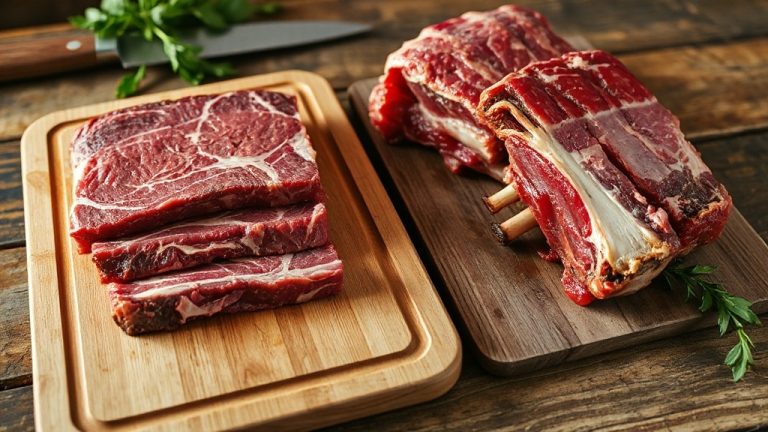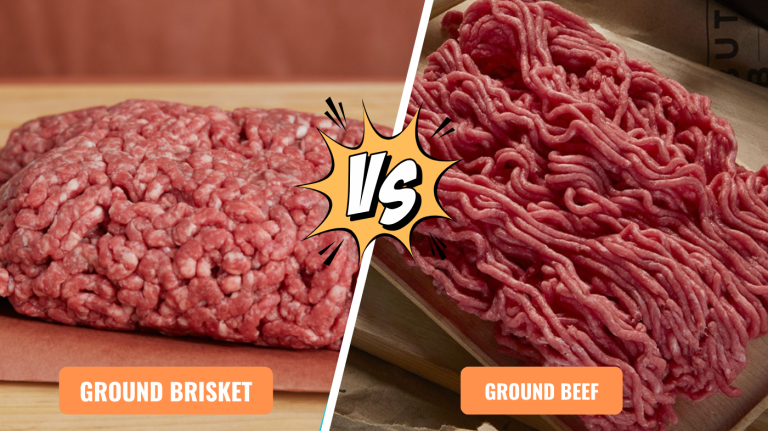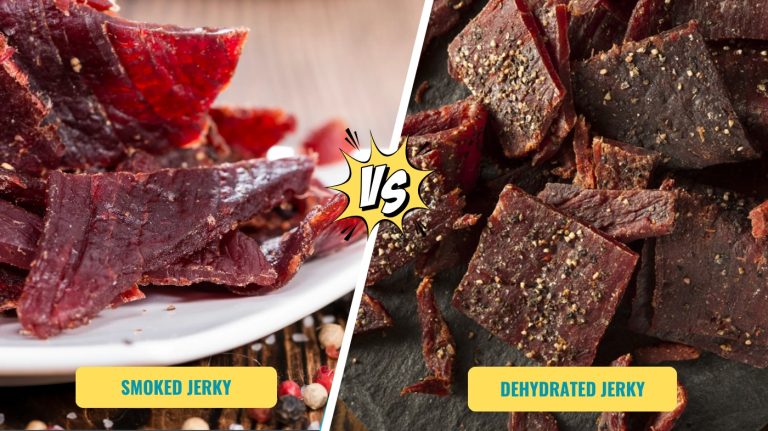Shoulder Clod vs Chuck Roll: Which Cut Reigns Supreme?
If you’re choosing between shoulder clod and chuck roll, consider their anatomy and cooking needs: shoulder clod is leaner, firmer, and contains distinct muscles like the teres major, offering a beefier flavor ideal for slow smoking or roasting.
Chuck roll has more marbling and connective tissue, making it richer and juicier, perfect for pulled beef or braising. Both need low, slow cooking for tenderness. Exploring their differences will help you pick the best cut for your meal.
Key Takeaways
- Shoulder clod is leaner, firmer, and beefier with distinct muscle layers, while chuck roll is more marbled, tender, and coarser-grained.
- Both cuts excel with slow, low-temp cooking like smoking or braising, but shoulder clod benefits from longer smoke times (12–16 hours) for tenderness.
- Chuck roll’s higher marbling enhances juiciness and flavor during cooking, making it great for pulled beef, while shoulder clod suits roasts or steaks.
- Shoulder clod provides higher protein and micronutrients with a healthier lipid profile, whereas chuck roll offers richer flavor due to connective tissue melting.
Shoulder Clod vs Chuck Roll Comparison Table
| Aspect | Shoulder Clod | Chuck Roll |
|---|---|---|
| Size & Weight | 8-15 lbs – smaller, more manageable | 15-32 lbs – larger, feeds crowds |
| Fat Content | Leaner with less marbling | Higher marbling and fat distribution |
| Texture | Firmer, denser muscle structure | More tender due to fat content |
| Flavor Profile | Beefier, more intense savory taste | Milder, richer flavor from marbling |
| Cooking Time | 12-16 hours smoking at 250°F | 8-12 hours smoking at 225-250°F |
| Best Cooking Methods | Slow roasting, smoking with careful moisture control | Braising, pulled beef applications |
| Internal Target Temp | 195-200°F for optimal tenderness | 190-200°F for shreddable texture |
| Ideal Use | Sliced roasts, steaks for smaller gatherings | Pulled/shredded beef for large groups |
| Key Challenge | Avoiding dryness due to lean nature | Managing longer cook times due to size |
Composition and Anatomical Differences
Although both the shoulder clod and chuck roll originate from the beef chuck primal, they occupy distinct anatomical positions and comprise different muscle groups.
The shoulder clod lies below and adjacent to the chuck roll, above the brisket, originating from the arm-on chuck’s outer muscle system. It contains three primary muscles: the top blade, shoulder center (triceps brachii), and shoulder tender (teres major), separated by connective tissue like sinew.
In contrast, the chuck roll is a larger, boneless muscle group surrounding the spine and scapula, including muscles such as the infraspinatus and complexus. It has more layered connective tissue and fat distributed differently.
Flavor and Texture Comparison
Understanding the distinct muscle compositions of the shoulder clod and chuck roll sets the stage for comparing their flavor and texture profiles.
You’ll find the shoulder clod offers a beefier, deeply savory flavor due to denser muscles and more connective tissue, resulting in a rich taste after slow cooking. In contrast, the chuck roll presents a milder, yet rich, flavor, enhanced by marbling and the tender chuck eye muscle.
Texture-wise, the clod is leaner and firmer, retaining some fibrousness even after cooking. Meanwhile, the chuck roll becomes uniformly tender and softer due to its fat distribution.
The lower marbling in clod demands careful slow cooking to avoid dryness, whereas chuck roll’s intramuscular fat improves juiciness and mouthfeel, offering a more buttery smooth texture.
Both cuts benefit from slow, low-temperature cooking to break down connective tissue and maximize tenderness.
Preferred Cooking Methods for Each Cut
When smoking shoulder clod, you’ll want to maintain a steady temperature of 250°F for 12 to 16 hours, aiming for an internal temperature between 195° and 200°F to break down the connective tissue fully.
Place it fat side up on the grate to baste the meat naturally. Inject it with beef stock and dark beer before smoking and mop hourly with a vinegar-beer-oil-hot sauce blend to preserve moisture and develop bark.
The shoulder clod is traditionally seasoned with a simple rub of coarse salt and black pepper to highlight its natural beef flavor.
Maintaining a consistent smoker temperature is crucial to prevent drying and ensure tender results, similar to controlling temperature during smoking techniques.
Chuck roll, smaller and leaner, smokes well at 225°–250°F for 8 to 12 hours. It benefits from marinating or injection but requires less frequent mopping. Both cuts demand precise monitoring with an instant-read thermometer and generous seasoning.
Alternatively, chuck roll excels in braising or low oven roasting, while shoulder clod adapts to indirect grilling or direct fire cooking for faster results.
Typical Weight and Pricing Insights
Beyond cooking techniques, the differences in typical weight and pricing between shoulder clod and chuck roll markedly impact your selection and preparation strategy.
The chuck roll, weighing 15–32 pounds, offers a lower price per pound (~$1.99), ideal for bulk cooking. Conversely, the smaller shoulder clod (8–15 pounds) costs more (~$2.79/lb) but yields more uniform, tender cuts. Your choice depends on portion size needs and budget constraints.
Both cuts come from the same beef region but differ in size and shape, which influences cooking time and handling. Understanding the marbling characteristics of these cuts can further guide your cooking method and flavor expectations.
| Cut | Typical Weight (lbs) | Average Price per Pound ($) |
|---|---|---|
| Chuck Roll | 15 – 32 | 1.99 |
| Shoulder Clod | 8 – 15 | 2.79 |
| Chuck Primal | ~100 (whole) | Varies |
Butchery and Fabrication Techniques
You’ll start by identifying natural muscle separations and connective tissue lines to efficiently separate the Shoulder Clod and Chuck Roll into distinct cuts.
The shoulder clod contains strong muscles and connective tissue, especially around the shoulder blade area, which guides precise cutting. Next, carefully remove bones to maximize usable meat while minimizing damage to surrounding muscles.
Throughout, focus on trimming fat and connective tissue strategically to optimize yield and enhance the quality of roasts, steaks, and other fabricated portions.
Proper trimming involves carefully peeling off the silver skin and removing excess fat to prepare cuts like the flatiron and teres major for cooking.
Muscle Separation Methods
Although muscle separation in the shoulder clod and chuck roll requires distinct approaches, both rely heavily on identifying natural seams and connective tissues to achieve clean, efficient cuts.
In the shoulder clod, you begin by locating the seam adjacent to the tricep to separate the Top Blade, cutting precisely along connective tissue without bone removal. You then divide the shoulder heart and Petite Tender, carefully slicing through sinew to preserve muscle integrity.
Traditionally, the Petite Tender was attached to the shoulder clod, but it is now often removed and sold separately as 114F Petite Tender.
For the chuck roll, you focus on isolating the chuck eye (longissimus dorsi) by removing tough tendons and connective veins beneath the blade and around bones like the humerus.
Bone Removal Processes
When removing bones from the shoulder clod and chuck roll, you start by carefully sectioning the chuck primal from the carcass, cutting around the shoulder blade and rib area to preserve muscle quality.
For the chuck roll, you remove ribs and scapula fragments to isolate the boneless subprimal. With the shoulder clod, you delicately extract the humerus and scapula, exposing its five primary muscles. Use boning knives for precision along anatomical seams, avoiding muscle fiber damage.
| Subprimal | Key Bones Removed |
|---|---|
| Chuck Roll | Ribs, scapula fragments |
| Shoulder Clod | Humerus, scapula |
| Both | Accessory cartilage |
Yield Optimization Strategies
Since maximizing yield directly impacts both product quality and profitability, mastering butchery and fabrication techniques for chuck roll and shoulder clod is essential.
Start by identifying key muscles, such as the longissimus dorsi in chuck rolls, to guide precise cuts. Trim excess and intermuscular fat carefully to enhance usable meat without sacrificing flavor.
When working on shoulder clods, focus on meticulous cutting around the humerus to recover maximum meat.
Section chuck rolls into sub-primal cuts like chuck eye and underblade to minimize waste. Utilize deboning techniques to facilitate efficient portioning.
Maintain grain direction during slicing to improve tenderness and reduce waste. Finally, apply low-temperature cooking methods like braising to preserve moisture, boosting yield and product appeal.
Controlling portion sizes ensures consistent yield and reduces loss during fabrication. Implementing temperature consistency in cooking can further enhance tenderness and overall product quality.
Nutritional Profile and Meat Quality
Because the shoulder clod comprises distinct muscles with varying fat and lean content, its nutritional profile and meat quality differ particularly from the chuck roll.
You’ll find the shoulder clod generally leaner, offering about 189 calories and high protein (up to 93.76 g per large portion) with moderate fat levels when trimmed properly.
It’s rich in key micronutrients like vitamin B12 (165% DV), selenium (61% DV), and zinc (47% DV), enhancing nutritional density. Additionally, it provides a substantial amount of vitamin B6, contributing to a well-rounded vitamin profile.
The choice of seasoning and sauce, such as a tangy BBQ sauce, can further complement the lean nature of shoulder clod meat.
In terms of meat quality, the shoulder clod’s Teres major muscle stands out for tenderness, comparable to tenderloin, making it suitable for quicker cooking methods.
Conversely, the chuck roll has more connective tissue and marbling, resulting in a coarser grain and richer flavor but increased chewiness.
Fatty acid profiles and cholesterol content vary accordingly, with shoulder clod cuts offering a healthier lipid balance.
Ideal Uses in Barbecue and Slow Cooking
When choosing between shoulder clod and chuck roll for smoking, consider the clod’s lean, multi-muscle composition that demands low, slow cooking to break down toughness and develop a robust beefy flavor.
The clod roast contains two tough accessory muscles that contribute to its firm texture, making it well-suited for stewing or braising. Oak wood’s slow burn rate provides steady heat that complements such long cooking methods.
The chuck roll’s abundant marbling melts during slow cooking, enhancing tenderness and moisture, making it ideal for pulled beef applications.
Best Cuts for Smoking
Although both chuck roll and shoulder clod excel in low and slow smoking methods, your choice depends on desired flavor, texture, and cooking logistics.
Chuck roll’s higher marbling yields a tender, juicy result ideal for shredding, while shoulder clod offers a leaner, beefier profile with firmer texture. The fat content notably influences juiciness and tenderness in slow-cooked barbecue.
Consider these factors when selecting:
- Chuck roll is larger (15-32 lbs), suited for feeding crowds and longer smoke times.
- Shoulder clod is smaller (8-15 lbs), better for moderate servings and leaner results.
- Top blade in shoulder clod provides enhanced marbling and tenderness.
- Smoking temperatures between 225-250°F until 190-200°F internal create ideal shreddable texture.
- Browning chuck roll before smoking deepens flavor; shoulder clod benefits from precise temperature control to avoid toughness.
- Since the clod consists of muscles from the upper arm, it is generally denser and tougher than chuck roll.
Choose based on size, fat content, and flavor intensity for superior barbecue performance.
Slow Cooking Techniques
Selecting between chuck roll and shoulder clod for smoking naturally leads to contemplating their performance in slow cooking methods. Chuck roll demands extended low-temperature cooking (18+ hours at 200°F–275°F) to render fat and collagen fully, yielding rich, tender, shreddable meat.
Shoulder clod cooks faster (5–7 hours) at slightly higher temps but requires added moisture to prevent dryness due to its leaner profile.
You’ll appreciate chuck roll’s forgiving nature and deep flavor development, while shoulder clod excels when sliced and served as roast.
The leaner beef shoulder roast reduces fat in sauce and helps the meat hold its shape when sliced, which is ideal for slow cooking recipes that focus on presentation.
| Attribute | Chuck Roll | Shoulder Clod |
|---|---|---|
| Cooking Time | 18+ hours (low temp) | 5–7 hours (higher) |
| Fat Content | High (marbled) | Low (lean) |
| Moisture Needs | Self-sufficient | Requires added liquid |
| Texture | Shreddable | Sliceable |
| Flavor Complexity | Rich, deep | Beefy, straightforward |
Flavor Profiles Breakdown
Because chuck roll develops a pronounced beefy flavor through its dense muscle fibers and connective tissue, it excels in barbecue applications that emphasize deep, robust taste profiles.
When slow-cooked, its connective tissue gelatinizes, releasing umami-rich compounds that intensify flavor complexity. You’ll find it particularly well-suited for low-and-slow smoking with techniques that preserve moisture and develop a balanced bark.
The meat’s muscle structure is more complex than brisket, consisting of multiple muscles, which may influence how it holds together during cooking.
- Ideal for Texas-style barbecue with salt and pepper rubs
- Benefits from gradual temperature increases to build crust
- Wood smoke like hickory complements without overpowering
- Requires 10–15 hours at low heat for optimum tenderness
- Extended resting redistributes juices, enhancing softness
This precise flavor profile and texture make chuck roll a versatile choice for slow cooking and barbecue enthusiasts seeking concentrated beef character.
Selecting the Right Cut Based on Occasion
When planning a meal, you’ll want to match your beef cut to the occasion’s scale, cooking method, and flavor emphasis. For formal dinners or smaller gatherings, the shoulder clod’s rich, beefy flavor and smaller size (8-20 lbs) make it ideal for roasts or steaks emphasizing bold taste.
In contrast, chuck roll suits casual events or large groups, weighing 15-32 lbs and offering value for bulk servings, especially for pulled or shredded beef. If you prefer quicker cooking like grilling, select chuck roll’s tender chuck eye section.
For slow cooking or smoking, both cuts benefit from extended time to tenderize tougher muscles. Budget and portion size also influence choice—shoulder clod commands a premium per pound, while chuck roll offers economical flexibility for larger meals.
Frequently Asked Questions
How Should I Store Shoulder Clod and Chuck Roll Before Cooking?
You should store beef at or below 40°F (4°C) to prevent bacterial growth, as temperatures above this increase contamination risk considerably.
Wrap the meat tightly in plastic wrap, then place it in airtight freezer bags to avoid freezer burn and moisture loss. Label packages with the date and cut type.
Portion large cuts to defrost only what you need. Keep meat away from strong odors to preserve flavor and maintain ideal freshness prior to cooking.
Can Shoulder Clod or Chuck Roll Be Used for Making Beef Jerky?
You can definitely use shoulder clod or chuck roll for beef jerky, but you’ll need to trim all fat and connective tissue to prevent spoilage and off-flavors.
Slice against the grain for tenderness. Shoulder clod offers a beefier flavor, while chuck roll provides varied textures due to mixed muscles.
Marinate tougher sections and dry low-and-slow to break down connective tissue, ensuring your jerky is flavorful and chewable.
What Are the Best Marinades for Enhancing Shoulder Clod Flavor?
For flavorful, tender shoulder clod, focus on acidic agents like citrus juices or vinegar to break down muscle fibers efficiently.
Combine these with oils—olive or sesame—to maintain moisture and enhance flavor absorption. Boost boldness with soy or Worcestershire sauce, garlic, and black pepper for complexity.
Inject marinades for deep distribution, marinate overnight for maximum penetration, and consider slow cooking or smoking to amplify taste through Maillard reaction and smoke infusion.
How Do Cooking Times Differ When Using a Smoker Versus an Oven?
You know what they say: slow and steady wins the race. When you use a smoker, you’re cooking low and slow at 225-250°F, which takes about 5-7 hours to reach the ideal 190-200°F internal temp for tender meat.
Oven cooking runs hotter, so it’s faster—usually 3-5 hours—but you risk drying out the meat without careful temperature control. Always monitor temps with a thermometer to nail perfect doneness and tenderness.
Choose the Right Cut for Your Cooking Goals
When choosing between the shoulder clod and chuck roll, you’ll find their differences in muscle composition and marbling coincidentally determine their best uses.
The shoulder clod’s leaner profile suits roasting and slicing, while the chuck roll’s abundant connective tissue excels in slow cooking and barbecue.
Understanding these distinctions guarantees you select the right cut for your recipe’s demands, maximizing flavor, texture, and value every time you cook.




